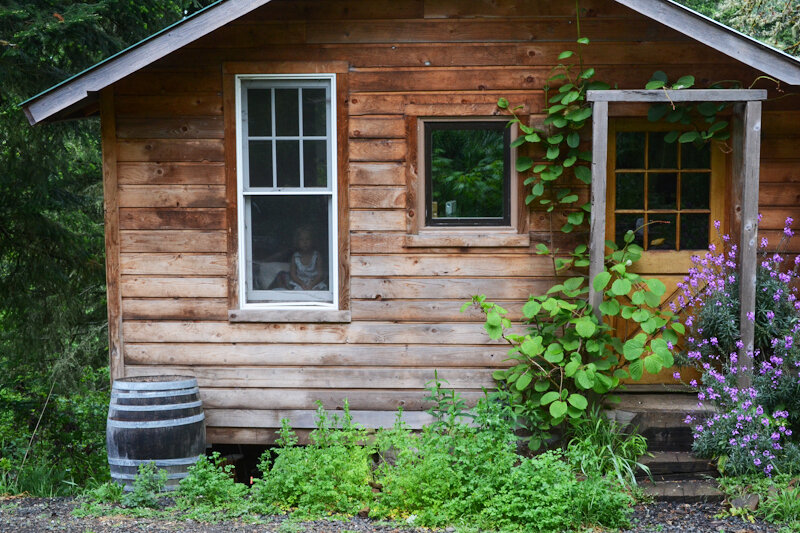
Camille Storch | Wayward Spark
The tagline of Camille’s blog is “Genuine, seasonal Americana” and it’s one of my favorite spots on the internet. If you’ve ever wanted to know the ins and outs of hosting a food swap or baking a loaf of bread in your barbecue, Camille is your woman. She and her husband, Henry, have lived in a tiny cabin off-the-grid in rural Oregon for nearly a dozen years. When Camille was pregnant with her first child, she and Henry expanded their cottage to a whopping 500 square feet and lived there with two kids—now 8 and 6—until earlier this fall. With a burgeoning honey business, Old Blue Raw Honey, Camille and Henry decided to find a space that was big enough to fulfill the needs of their family and small business. (Electricity and storage space both being key.) I recently had the chance to ask Camille a bit about the life they’re leaving behind and their transition to someplace new. Erin: Can you set the scene for us? What is it like to live “off the grid?” I think some people might envision Laura Ingalls Wilder and Little House in the Big Woods. What’s the reality?
Erin: Can you set the scene for us? What is it like to live “off the grid?” I think some people might envision Laura Ingalls Wilder and Little House in the Big Woods. What’s the reality?
Camille: For us—and in no way do I want to make generalizations about all or most folks living off-grid—our lives included a mix of Little House in the Big Woods tropes as well as very modern elements. We were fortunate enough to have plenty of running water (from a well and a spring), a propane water heater, a small refrigerator (also propane), a flush toilet, and fast (expensive!) internet through our cell service. After a few years of sweeping dog hair in circles around the cabin, my mother-in-law bought me a Makita dust buster-style vacuum that was truly a godsend. We had a wood stove and wood from our property that we cut and split ourselves every year to heat the house, and an AM/FM radio perpetually tuned to NPR to entertain us.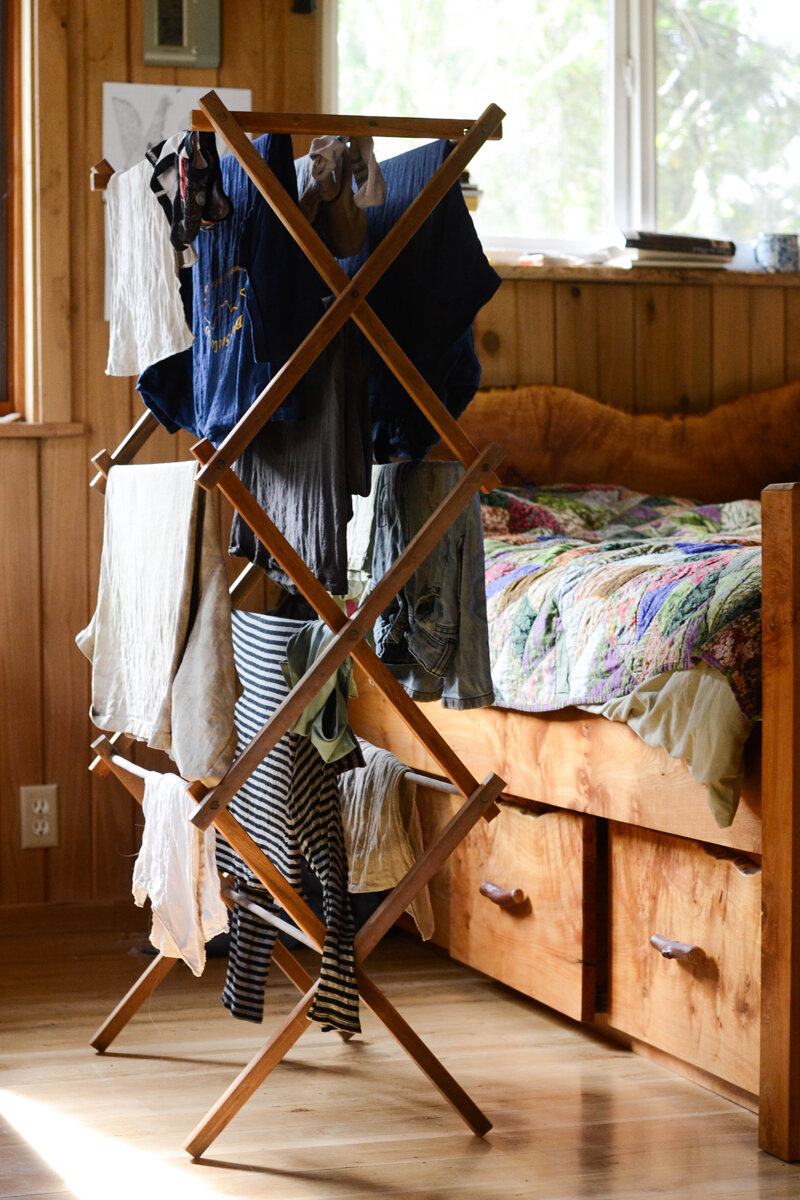 [Cont.] The biggest difference in our off-grid tiny living versus apartment tiny living was probably the light or lack thereof. In the late spring, summer, and early fall, it wasn’t a problem because daylight was generally good enough and when we did need artificial lights, the solar panels were fully charged and ready to power the 12-volt marine lights we had installed in the house. Around this time of year, however, we would start to crave more light but have less and less of it. The solar panels weren’t catching many rays, so our battery bank would often be near depletion so that even our dim-at-best light fixtures would barely emit anything at all. We grew to be anal about switching off any non-critical lights, and we’d often end up sitting in the dark, staring at our glowing smart phones or just going to bed early. My energy and motivation went down with the sun, so winter was always a dark period even though we didn’t often face the snowstorms that the Ingalls did. Candlelight is romantic for all of five minutes, but if you’ve ever tried to read or do anything productive with only candles for illumination, it gets very tiresome very quickly.
[Cont.] The biggest difference in our off-grid tiny living versus apartment tiny living was probably the light or lack thereof. In the late spring, summer, and early fall, it wasn’t a problem because daylight was generally good enough and when we did need artificial lights, the solar panels were fully charged and ready to power the 12-volt marine lights we had installed in the house. Around this time of year, however, we would start to crave more light but have less and less of it. The solar panels weren’t catching many rays, so our battery bank would often be near depletion so that even our dim-at-best light fixtures would barely emit anything at all. We grew to be anal about switching off any non-critical lights, and we’d often end up sitting in the dark, staring at our glowing smart phones or just going to bed early. My energy and motivation went down with the sun, so winter was always a dark period even though we didn’t often face the snowstorms that the Ingalls did. Candlelight is romantic for all of five minutes, but if you’ve ever tried to read or do anything productive with only candles for illumination, it gets very tiresome very quickly.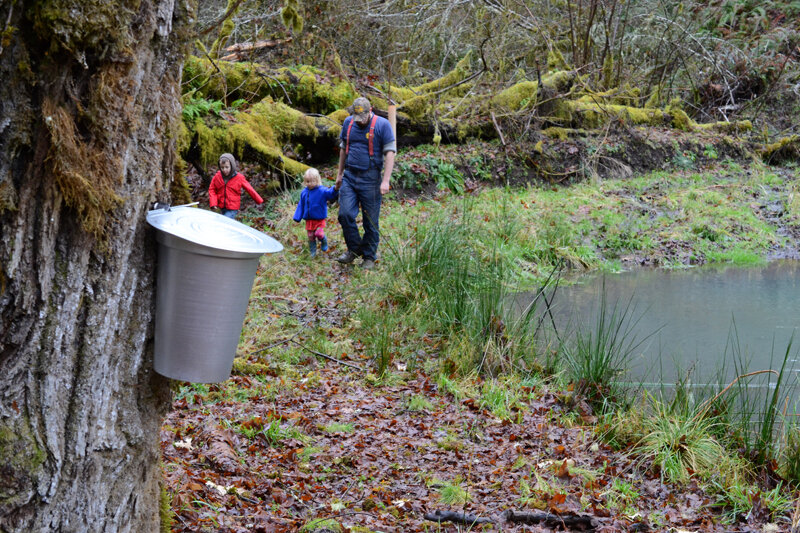 The most Little House activity we ever did during our time in the cabin was make our own maple syrup, and it was a super fun project (if you’re into watching pots boil). You can read and see more about it here, here, and here.
The most Little House activity we ever did during our time in the cabin was make our own maple syrup, and it was a super fun project (if you’re into watching pots boil). You can read and see more about it here, here, and here.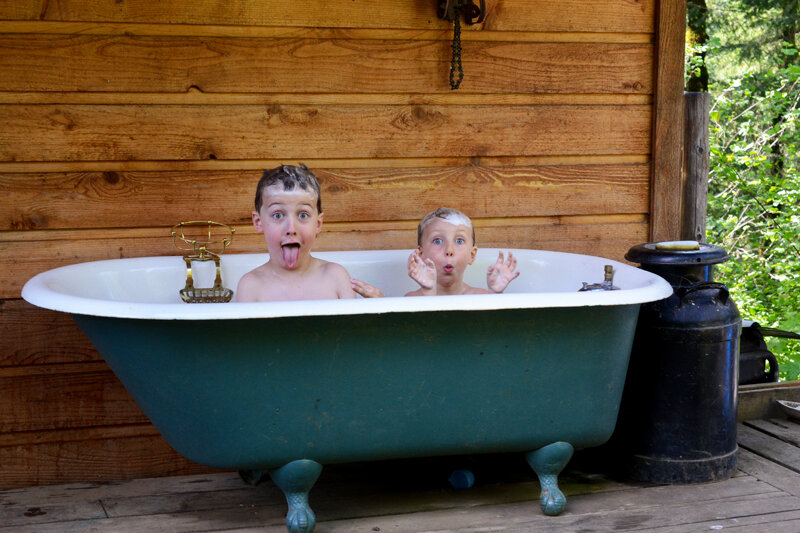
Erin: Your instagram feed often features adorable photos of your kids (the shots of them bathing in the clawfoot tub on your cottage porch are my personal favorites). When you first moved to the cabin with Henry did you imagine raising two kids there?
Camille: With help from his brother and his dad, Henry built the original part of the cabin to be a somewhat temporary bachelor shack before I was really on the scene. It was not constructed to house four people for 10+ years. When I first moved in, the whole building was under 200 square feet, and we’d eat dinner every night while sitting on the bed because it was basically our only piece of furniture, and there was a negligible amount of free floor space. We lived like that for two years until we decided to add on another room when I was a few months pregnant.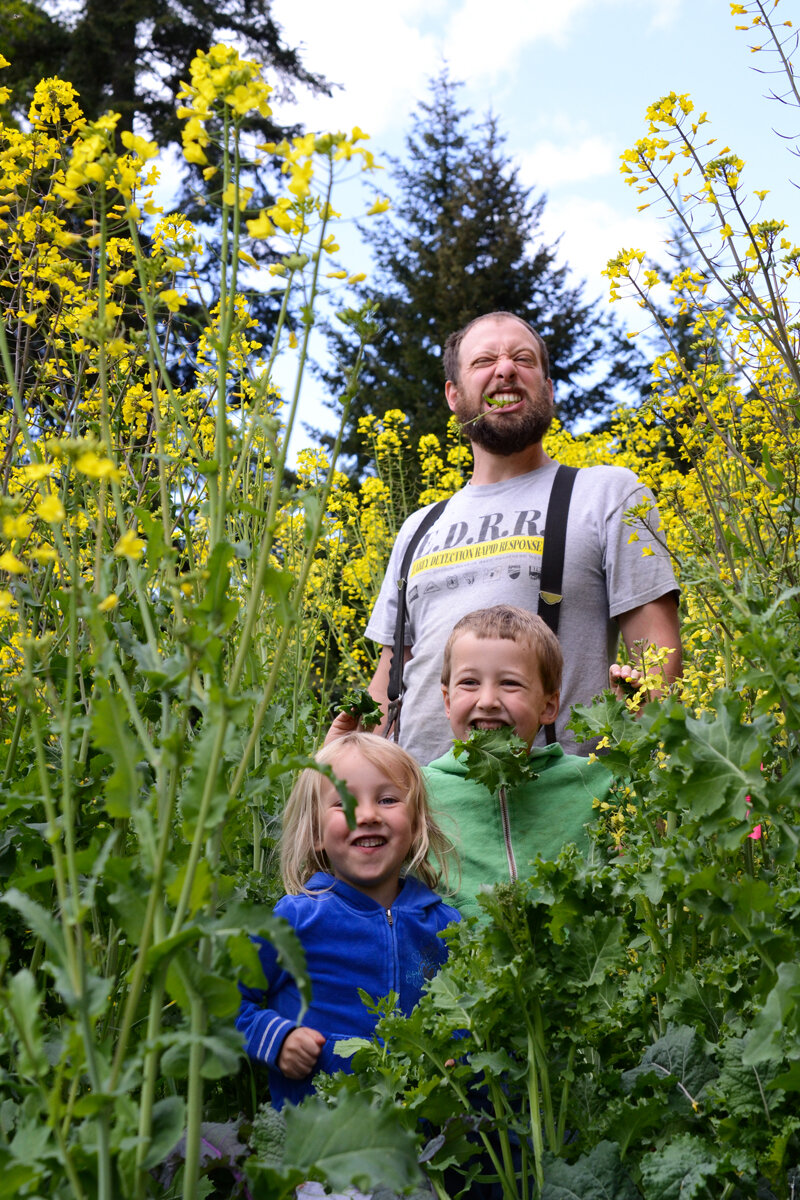 Erin: Do you think there are particular values that you’ve been able to instill in your children as a result of your living situation?
Erin: Do you think there are particular values that you’ve been able to instill in your children as a result of your living situation?
Camille: Overall, I think raising young kids in a very small space was truly, honestly the best thing for us and them (and arguably most parents and kids). When I was pregnant for the first time, we knew we couldn’t possibly have ALL the baby gear that people and commercial society insisted we “needed”, so we invested in a few essentials: car seat, cloth diapers, some clothes, two great baby wearing devices (a Moby wrap and an Ergo), a miracle bouncy chair (by Baby Bjorn), a dresser/changing table, and a crib (though we went through cycles of co-sleeping and not with both kids). Eventually we added a toy box, some toys, tons of books, craft supplies, some outdoor play things, and bigger beds. (Both kids slept together in a twin bed for about two years until they graduated to bunk beds.) When we moved recently, all of the kids’ clothes, toys, and books fit in the back of my station wagon with room to spare.
The thing about not having a lot of space is that it’s the best excuse for refusing all the junk (arguably valuable junk) that well-meaning people want to give you, especially if you have kids. When we got married, we asked our guests to make charitable donations in lieu of gifts, and while many did, others just gave us cash or small, highly useful presents. When the kids were born, our friends and family knew not to buy us a giant electric swing or a thousand stuffed animals. We coached everyone to either ask what we needed or to give us food instead of presents. As the kids grew older, they also grew to understand that they couldn’t have everything they wanted because more stuff simply wouldn’t fit in our house. Somehow we always made room for books and Legos, but we also said no a lot, and that was okay, too. I should mention that from the beginning, our kids have spent a lot of time at their various grandparents’ houses, and curiously enough, all the obnoxious, noise-making toys and larger kid items ended up with Nana, Papa, Granny, Grandpa Jeep, and Grandma Jo.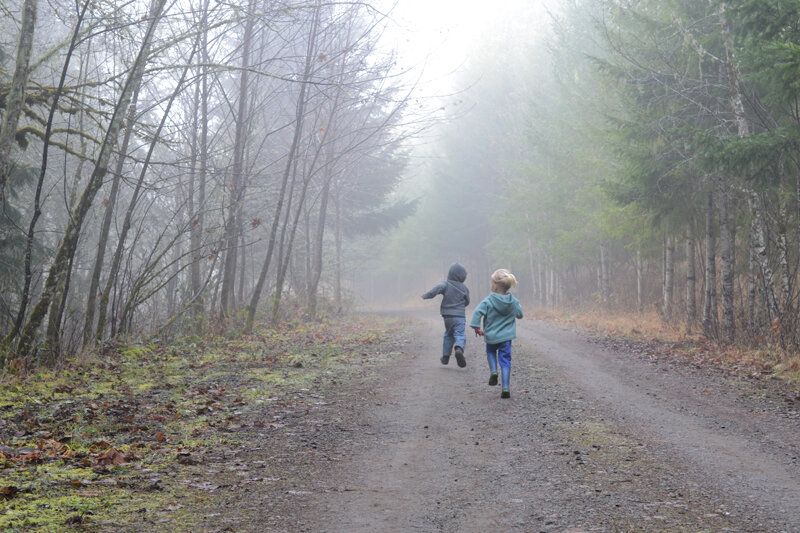
[Cont.] When the kids were babies and toddlers, they were remarkably easy to keep track of in our tiny cabin. In the rare cases where I couldn’t see them, I knew I should check in when it got too quiet for too long. We were really worried about the unguarded wood stove early on, but one of Levi’s first words was “hot”, and there weren’t ever any incidents. Frequent middle-of-the-night wake ups required less traveling from bed to baby and back, though as they got older, we sometimes wished there was more distance/walls between us at times (see this hilarious but 100% true piece).
I’m a big proponent of the parenting theory that boredom (to a degree) breeds creativity, and though my husband and I wouldn’t win any awards for world’s greatest parents, the combination of limited toys and playthings along with virtually no screen time has yielded two highly bright, inquisitive, and well-adjusted kids. Neither one seems to be scarred by our experiences with tiny house living, and though they’re gradually realizing that the way we have lived is different from their peers, they don’t believe they’re worse off for it.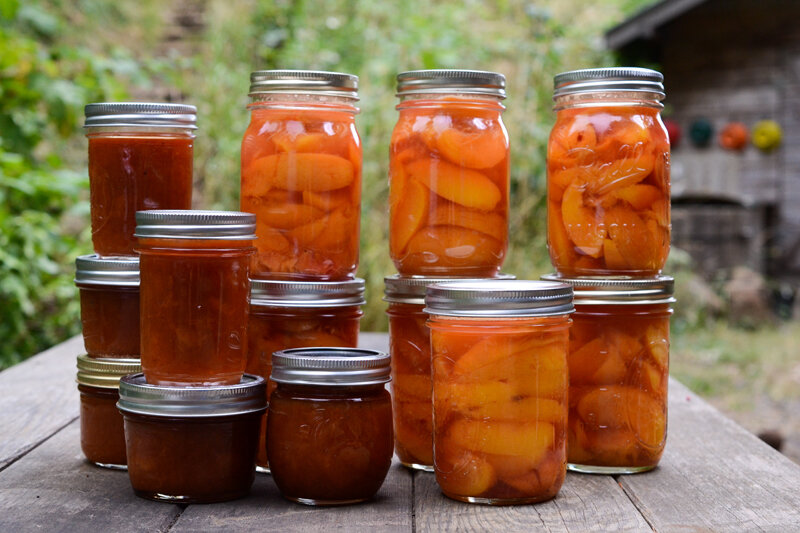
Erin: I struggle a bit myself with the word minimalist, and yet I’m definitely someone who believes that less is more. You’ve raised two kids in limited space in a remote area, but I know you also have, for instance, a cast iron pan collection. And you always seem to be working on one home project or another—brewing kombucha, putting up fruits and veggies. Are there things that you’ve managed to live with or do in a small space that might surprise people?
Camille: Well, the only way I can sort of justify my cast iron collection as well as my collection of colorful enameled colanders is that they’ve always been hung on the wall and therefore never took up valuable real estate. Hanging things on wall hooks or on our two sizable pot racks was my best trick for cramming a ton of stuff into a tiny kitchen. One of the biggest head-scratchers of moving into a larger kitchen in our new home is that there really isn’t a good place to hang things on the walls because there are so many cupboards, whereas in the cabin, we had pitifully few cupboards (like two). There’s also no good place for a pot rack, so even though I don’t have matching dishes or super nice cookware, I’m mourning the fact that I have to stuff it all away behind closed doors until I find a way to display things better. The thing I love about hanging functional items is that it eliminates the need to decorate, at which I am hopeless.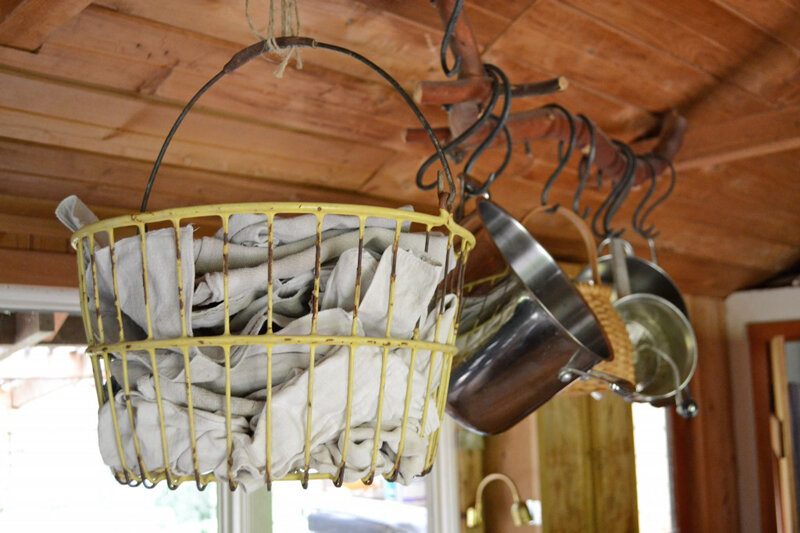
[Cont.] I did a lot of canning at the old house, probably totaling in the thousands of jars over ten years. The tiny kitchen was less than ideal, but there were a few things that worked really well. Our two-burner propane stovetop was directly next to our big sink, so when I was blanching tomatoes/peaches to get the skins off, I’d just fill the sink up with cold water and plop the hot fruit directly into the sink instead of transferring bowls of ice water around the kitchen. The best thing about a tiny kitchen is that basically everything is within reach when you’re in the middle of a cooking project. Chefs talk about walking a bajillion steps a day as they cruise around their domain, but even though I was on my feet a lot, I never had to travel far.
The other canning tip that I now consider essential is owning an outdoor propane burner (sometimes called a turkey fryer) that boils the heck out of water in a hurry. I always did my food prep and jar stuffing inside the house, but when it came time to water-bathe canned things, all the boiling got done outside, so not only did I get that heat out of my house in the dog days of summer, but I also freed up burner space and kitchen space in general so that I could move on to the next project while the last one was still in the canner pot.
I don’t feel like there’s a lot that I’ve had to forgo because we didn’t have enough space, although toward the end, my burgeoning kombucha experiments were starting to seriously encroach on our ability to have more than two people sitting and eating at the kitchen table simultaneously.
The one space-hogging thing I’m looking forward to at the new house is setting up a designated craft area for the kids. I’m not particularly crafty, but I’d like a place where I can leave supplies out for kids to use and make messes but also be able to clean said messes up without too much effort. It will also be nice to have a little more elbow room and counter space in the kitchen for kids to get involved in cooking projects.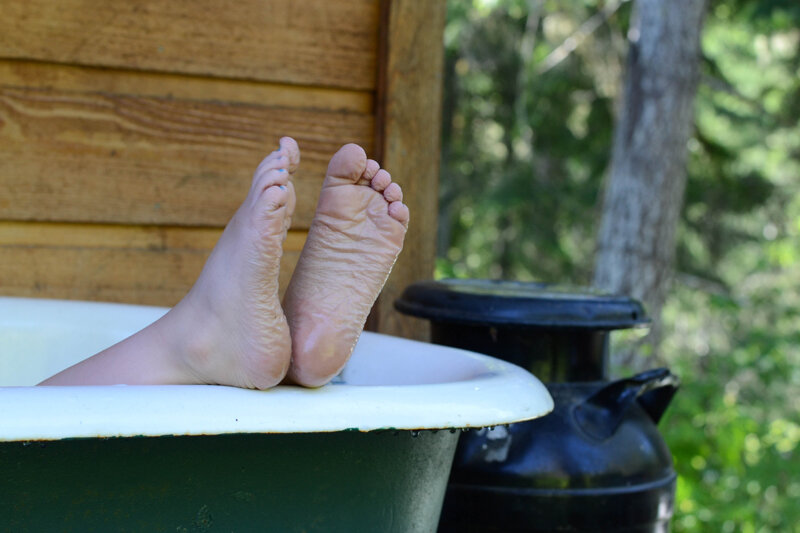 Erin: When we met each other on a visit you took to New York last fall, we talked a bit about the differences between urban and country living. What about your remote location do you think made small-space living more tolerable? What made it more challenging?
Erin: When we met each other on a visit you took to New York last fall, we talked a bit about the differences between urban and country living. What about your remote location do you think made small-space living more tolerable? What made it more challenging?
Camille: The outdoor space and privacy made it more tolerable. The (literal) darkness and isolation made it less tolerable.
Our property in the woods is beautiful and quiet and mostly free of the hazards and distractions of urban life (though the “cougar incidents” this spring scared me like I’ve never been afraid before). We know and love a few of our neighbors, but mostly we just did whatever the hell we wanted to do out there, and no one cared or even knew what we were up to.
Most of our friends’ houses and places we’d like to spend time (grocery stores, restaurants, parks, concerts, etc.) were at least a 30 minute drive away from home, so we spent a ton of time in the car. We also missed out on a lot of activities and opportunities because it seemed like too much of an effort to leave home, especially in the evenings, knowing we’d have to navigate dark, deer-filled roads to get home.
In New York, everyone is practically on top of each other all the time, which I imagine would be grating, but if you don’t want to be alone, you can walk out your front door at any time of day or night and find something to do and people to be with. That quality has a special appeal to someone like me, though I probably couldn’t handle living it every single day.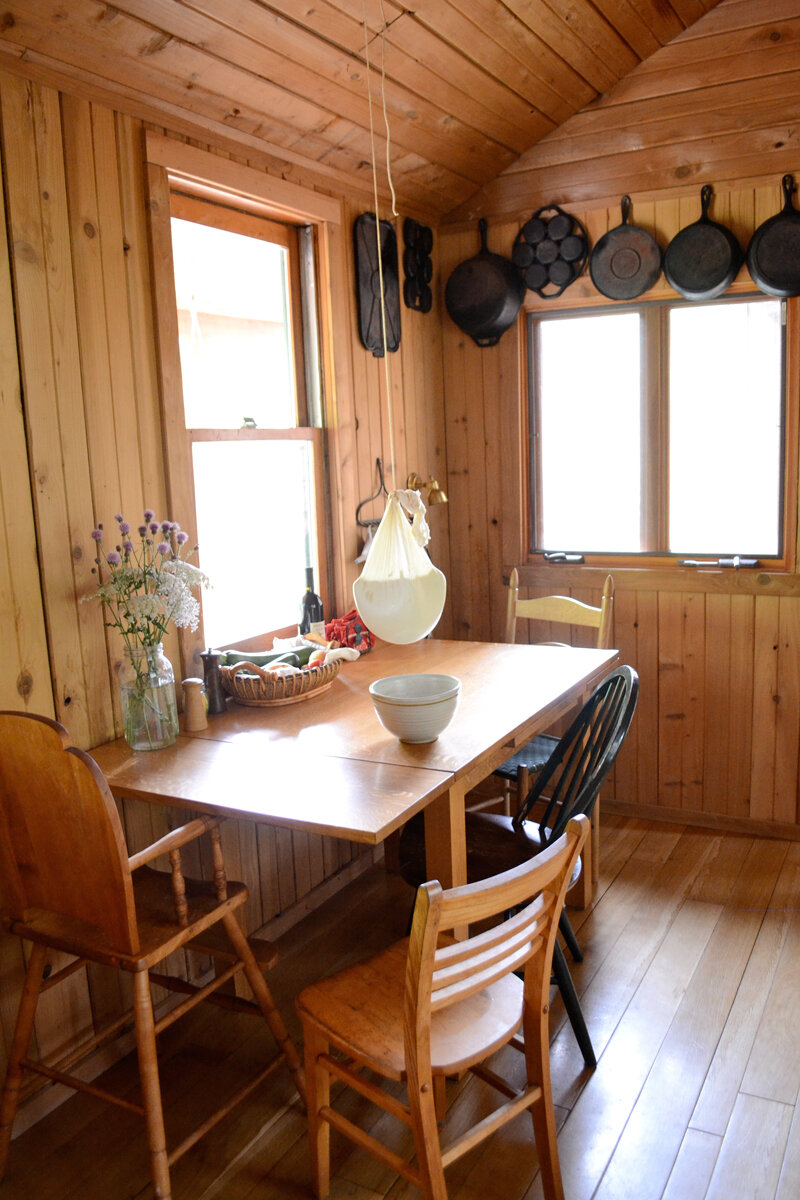
Erin: When we moved a year and half ago and doubled our square footage (to nearly 500), people often asked me if I’d be tempted to fill it up with stuff. My answer was always no, but I wonder if this is something that’s crossed your mind. How do you think moving into a larger space will affect your day-to-day life? Are there elements of your life in the cabin that you’re hoping to replicate in your new space?
Camille: Since closing on the new house, I have so far purchased: a food processor, a toaster oven, an electric toothbrush (as per my dentist’s recommendations for the past 10 years), a bathmat, a shower curtain, and a few hand towels. Our house is still in total disarray because of the recent move, but we will eventually be sorely lacking furniture. The plan is to buy a few chairs and end tables, hopefully used, all worn and warm and comfortable. I would also love to have a nice couch, but I don’t think we can afford one right now, so things might look bare for a while.
The mindset issue that I’m having trouble with right now is my instinct to cram, hang, tuck, and wedge our possessions into every available space when our new situation has way more available space than our possessions could ever fill. My son’s underwear doesn’t have to share a drawer with spare pillowcases anymore. Cookbooks and picture books can be on separate shelves or even separate bookcases.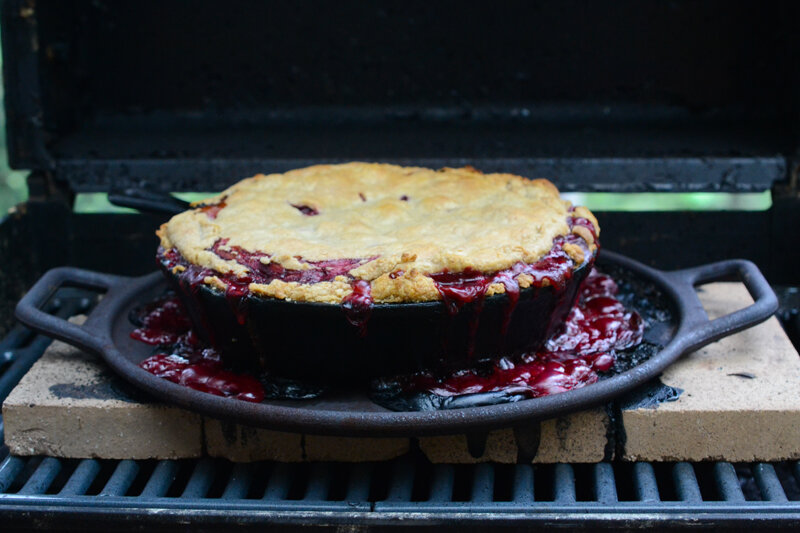
[Cont.] Up until this point, I spent basically my entire adult life in the cabin. When I moved in there, I brought almost nothing with me because it literally wouldn’t fit, and as a 22-year-old, I didn’t really have any nice stuff that I wanted to keep. Over the years, I have acquired a considerable number of things that are both functional and meaningful to me, but toward the end of our time in the cabin, I started to feel overwhelmed and claustrophobic about packing the place so full and having random kitchenware stored on the floor because I couldn’t think of anywhere better to keep it. I knew if we didn’t find a house to buy soon, I would have to do a big round of purging, but that made me super sad because I would have to get rid of things I really didn’t want to get rid of.
Now I’m fortunate enough to have the space for all my stuff and then some, but I’d like to think my measured approach to bringing new possessions into my life and home will remain about the same.The old cabin had character up the wazoo (wood paneling on the walls and ceiling, bathtub on the porch, mismatched windows and doors, etc.), but the new house doesn’t have much character at all. While I’m totally sick of the wood on wood with wood motif of the old house, and I’m loving the white walls of the new one, I would like to introduce some elements of the cabin’s rustic charm to this place, maybe in the form of art on the walls, maybe in the form of a creative cast iron collection display. I’m not sure how that’s going to play out.
I will say that I am absolutely loving the artificial light on these darkening fall evenings. Even the God-awful florescent light in the kitchen makes me feel like being incredibly productive after the sun goes down, something I haven’t experienced at home in the last 10 years. I will not miss dark cabin nights one bit!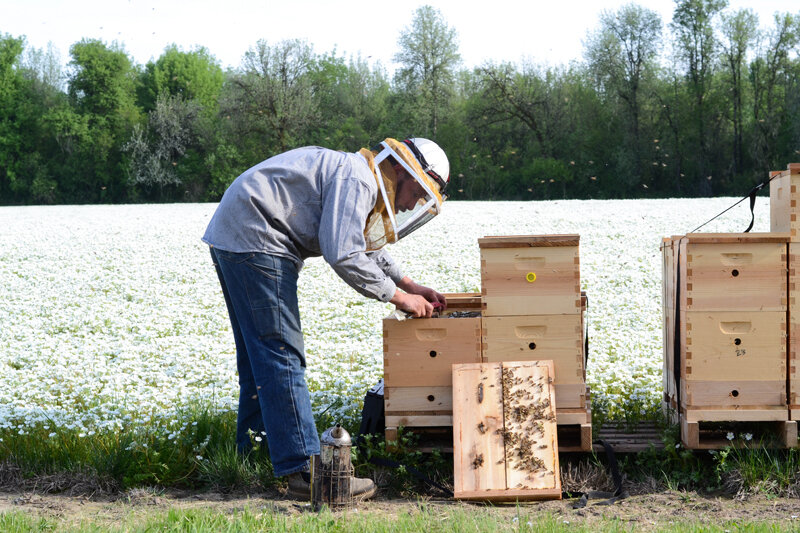
Erin: How do you think this move might affect your family’s business, Old Blue Raw Honey?
Camille: An urgent need to have all of our business operations based in one place was a huge driver in our decision to move. Though we’ve been able to get by for the last few years by extracting honey in our beekeeping friends’ facility, bottling in Henry’s mom’s kitchen, and storing and shipping honey out of my parents’ spare bedroom, that system was hugely inefficient. As we were house hunting—increasingly desperately for over a year—one of the key criteria in a new place was an existing shop space that could be converted into an extraction facility or the space to build such a facility from the ground up.
Where we’ve settled has a three-bedroom house and two acres of property. For now at least, the kids are sharing one of the bedrooms, and I’m using another one as an office and for honey storage and shipping. One entire wall is covered in shelving and stacked high with boxes of honey organized by varietal (at least 17 at last count). It’s pretty much a dream come true for me after trying to operate in wildly disorganized spaces where I was always tripping over piles of shipping supplies.
The next big step for us and our business is the construction of a large building that will eventually be an extraction facility, bee box storage, honey storage, bottling space, and maybe a tasting room. We’ve already cleared out a space on our property and prepped the site. We’ve been talking through potential configurations of the building, and I think we’ve settled on a design that will really minimize waste—wasted honey, wasted space, wasted electricity—by relying heavily on gravity instead of pumps for draining honey and separating out bits of wax. We’re hoping to begin construction after the holidays so that we’ll be ready to do small-batch extractions next spring. Finishing out the honey house, especially non-critical spaces like the tasting room, will probably take several years because we always prioritize keeping healthy bees and producing rad varietal honeys over material improvements, and our funds are particularly limited right now. That said, we’re hoping to have a successful holiday sales season so that we can get a roof, walls, and extraction equipment installed before the honey season is upon us again.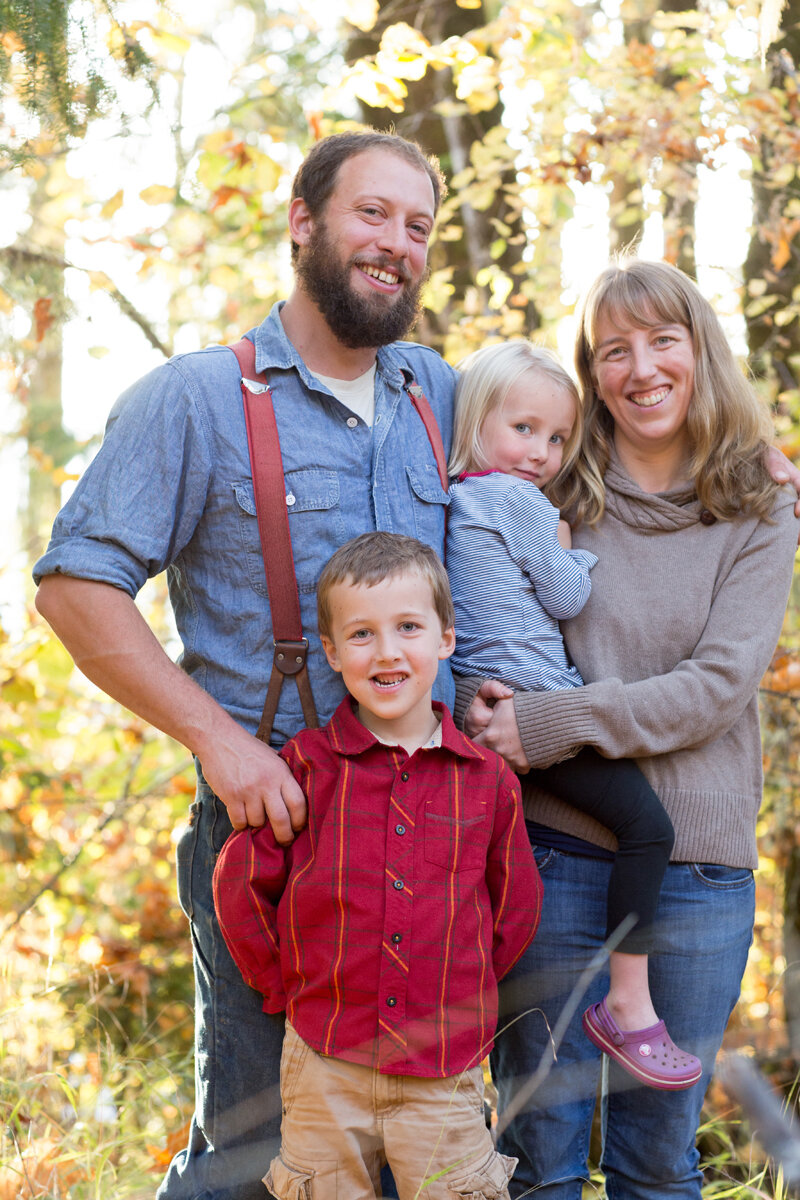
+ Hear more from Camille on her blog, Wayward Spark.
+ Keep up with daily goings-on on Camille’s Instagram account, @waywardspark.
+ Follow her husband Henry’s honey-related news at @oldbluerawhoney.
+ Stock upon holiday honey orders, head to the Old Blue Raw Honey online shop.
The Simple Matters Series is inspired in part by curiosity piqued while writing my book of the same title. I wanted to know what simple matters were for other folks. And why simplicity mattered to them in the first place. My own story comes out on January 12, 2016. It’s available for pre-order right this way.
Photos by Camille Storch for Wayward Spark. Last photo of the Storch family by Becerra Photography.

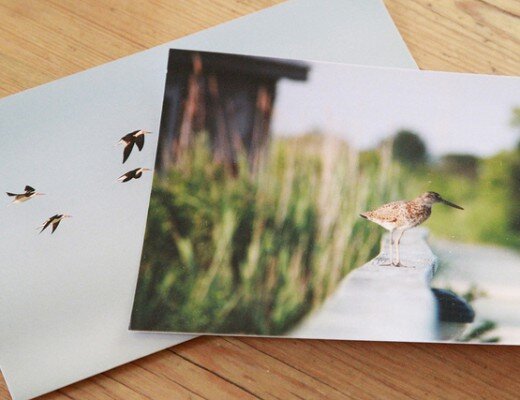
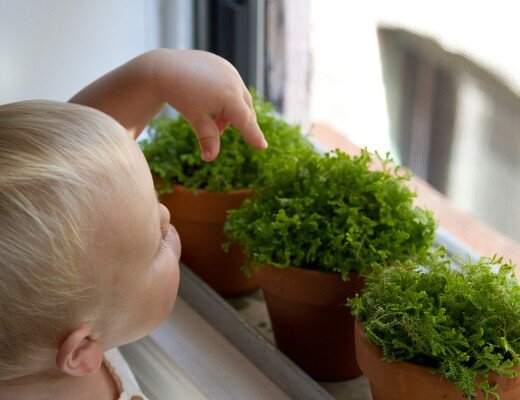
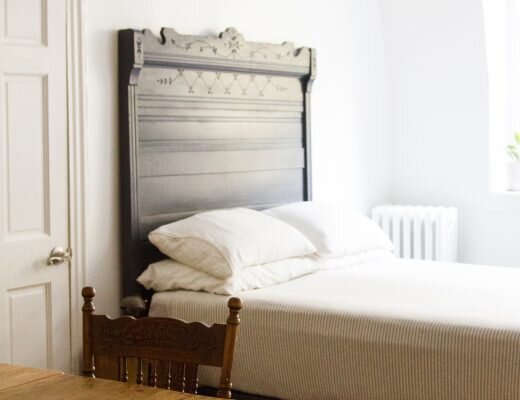
8 Comments
I have really been enjoying this series because in addition to talking about the joys of their living arrangements, the people you have featured have also talked about the difficulties of their arrangements. I appreciate the honesty and nuance because our living arrangements are almost never all good or all bad.
I doubt you’ll see this but Camille, your house and your family are both so beautiful.
This post is so fascinating! I love camping so I have a small glimpse of what living off the grid with only basic necessities might mean. Camping is always a great reminder of what things in your life you can do without, so I can imagine this family has a great appreciation of what material possessions we truly need to make ourselves happy.
I grew up in a three-bedroom house on two acres that was, for many, many years prior, a bee-keeping property. Your family’s journey is inspiring, Camille. Best to you! And great read, Erin!
This life looks so beautiful. The trick is taking the plunge and having the knowledge to make it work. This is so inspiring! Thank you!!
Helen XO
Les Petits Gazette
This family sounded so familiar to me and I just remembered why… One of my favorite articles in the latest Taproot magazine. How funny to read about them again! These guys are inspiring!
I am really enjoying this series and love discovering new (to me) blogs as a result. Thank you to Camille for sharing a peak into your home and lifestyle!
I spy challah!
Comments are moderated.